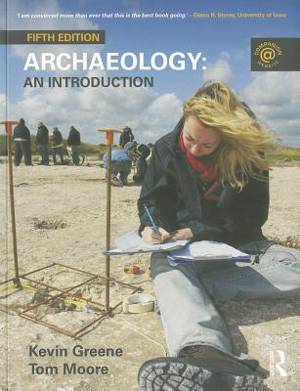
- Afhalen na 1 uur in een winkel met voorraad
- Gratis thuislevering in België vanaf € 30
- Ruim aanbod met 7 miljoen producten
- Afhalen na 1 uur in een winkel met voorraad
- Gratis thuislevering in België vanaf € 30
- Ruim aanbod met 7 miljoen producten
Omschrijving
Archaeology: An Introduction looks behind the popular aspects of archaeology such as the discovery and excavation of sites, the study of human remains and animal bones, radiocarbon dating, museums and 'heritage' displays, and reveals the methods used by archaeologists. It also explains how the subject emerged from an amateur pursuit in the eighteenth century into a serious discipline, and explores changing fashions in interpretation in recent decades.
This fifth edition has been updated by a new co-author, Tom Moore, and continues to include key references and guidance to help new readers find their way through the ever expanding range of archaeological publications. It conveys the excitement of new archaeological discoveries that appear on television or in newspapers while helping readers to evaluate them by explaining the methods and theories that lie behind them. Above all, while serving as a lucid textbook, it remains a very accessible account that will interest a wide readership. In addition to drawing upon examples and case studies from many regions of the world and periods of the past, it incorporates the authors' own fieldwork, research and teaching and features a new four-colour text design and colour illustrations plus an additional 50 topic boxes.
The comprehensive glossary and bibliography are complemented by a support website hosted by Routledge to assist further study and wider learning. It includes chapter overviews, a testbank of questions, powerpoint discussion questions, web-links to support material for every chapter plus an online glossary and image bank.
New to the fifth edition:
- inclusion of the latest survey techniques
- updated material on the development in dating, DNA analysis, isotopes and population movement
- coverage of new themes such as identity and personhood
- how different societies are defined from an anthropological point of view and the implications of this for archaeological interpretation
- the impact of climate change and sustainability on heritage management
- more on the history of archaeology
Visit the companion website at www.routledge.com/textbooks/greene for additional resources, including:
- chapter overviews
- a testbank of questions
- PowerPoint discussion questions
- links to support material for every chapter
- an online glossary and image bank
Specificaties
Betrokkenen
- Auteur(s):
- Uitgeverij:
Inhoud
- Aantal bladzijden:
- 416
- Taal:
- Engels
Eigenschappen
- Productcode (EAN):
- 9780415496391
- Verschijningsdatum:
- 17/05/2010
- Uitvoering:
- Paperback
- Formaat:
- Trade paperback (VS)
- Afmetingen:
- 189 mm x 246 mm
- Gewicht:
- 883 g

Alleen bij Standaard Boekhandel
Beoordelingen
We publiceren alleen reviews die voldoen aan de voorwaarden voor reviews. Bekijk onze voorwaarden voor reviews.











